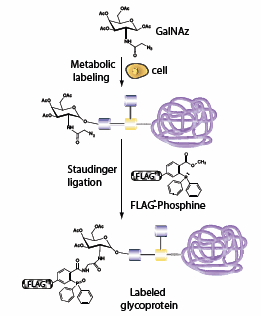The GlycoProfile™ Azido Sugar portfolio consists of three peracetylated azido sugars that may be incorporated into glycan structures chemically or by using existing biosynthetic pathways of mammalian cells.1 Orthogonally to chemical and biological carbohydrate or peptide synthesis, the azide moiety offers an ideal anchor to attach the modified glycan to surfaces, labels, peptides, or proteins. Labelling even works in vivo by using an alternative metabolic-system approach. The acetyl groups increase cell permeability and allow the unnatural sugars to easily pass through the cell membrane. Carboxyesterases remove the acetyl groups once the monosaccharide is in the cell. Cells metabolize the azido sugars using glycosyltransferases and express the sugars on the terminus of a glycan chain both intracelullarly and on the cell surface, leaving the azido group unreacted. N-Azidoacetylmannosamine may also be introduced into the sialic acid biosynthesis pathway. A phosphine probe containing a detection epitope such as the FLAG® peptide can be selectively bound to the glycan by Staudinger Ligation, resulting in a post-translationally modified glycoprotein that is detected in vivo by using a FLAG®-specific antibody. This approach permits the analysis of pathways that are regulated by particular glycan post-translational modifications as well as the monitoring of the intracellular glycosylation process itself.

Profiling O-type glycoproteins by metabolic labeling with an azido GalNAc analog (GalNAz) followed by Staudinger ligation with a phosphine probe (FLAG-phosphine).
Materials
References
To continue reading please sign in or create an account.
Don't Have An Account?